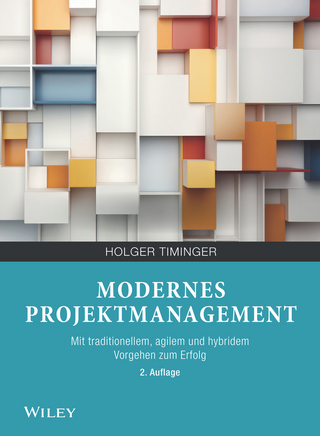
The Organizational Engineering Approach to Project Management
St Lucie Press (Verlag)
978-1-57444-322-6 (ISBN)
- Titel ist leider vergriffen;
keine Neuauflage - Artikel merken
Despite the advent of new methodologies and powerful tools, many projects continue to fail even when applying the well-accepted criteria of successful projects. These dismal results beg the question: If new methodologies and tools don't really impact project results, what does? Studies from major think tanks agree: people problems are the number-one challenge of team projects. The Organizational Engineering Approach to Project Management presents a powerful new way for harnessing the power of people and directing it to achieve the goals of any project.
Organizational engineering (OE) seeks to understand, measure, predict and guide the behavior of groups of people. I-Opt™ is an instrument used to ascertain the strategic styles of an individual. It measures the different ways people learn and apply their conclusions, thus opening the door to accurate predictions. Using the principles of OE and I-Opt™ in combination, the text presents a proven approach to managing projects. These principles have been successful in substantially improving project performance in numerous Fortune 500 companies as well as in mid-size and smaller companies.
The Organizational Engineering Approach to Project Management is the first book to apply OE and I-Opt™ to project management. The authors clearly explain this unique OE / I-Opt™ approach and how to use it effectively at any company or industry that utilizes project management. The text presents the rudiments of OE, explains the applicability of OE from a project management perspective, shows how to apply OE to common people issues, and concludes by providing step-by-step applications for new and existing projects.
The concepts and techniques presented in this text will help you:
Adapt to changing situations
Apply the most appropriate and effective level of project management disciplines
Maximize individual and team strengths
Minimize individual and team weaknesses
Match people to more appropriate tasks
Dedication
Acknowledgement
List of Tables
List of Illustrations
Preface
THE BASICS OF ORGANIZATIONAL ENGINEERING (OE) AND I-Opt™
THE RECORD TELLS IT ALL
New Paradigm
Future Challenges
Consequences of Challenges
New Tool for Today and Beyond
Desired Result
Proven Track Record
Summary
THE ELEMENTS OF OE
Assumptions of OE
The Fundamentals
Behavior Patterns Styles
Display a Profile
Characteristics of a Style
Core Ingredients
Summary
THE WORLD OF THE RELATIONAL INNOVATOR
Descriptions
Characteristics of Behavior
Probabilities of Success
Good Marriage
Summary
THE WORLD O91F THE HYPOTHETICAL ANALYZER
Descriptions
Characteristics of Behavior
Probabilities of Success
Mind Power
Summary
THE WORLD OF THE LOGICAL PROCESSOR
Descriptions
Characteristics of Behavior
Probabilities of Success
Order!
Summary
THE WORLD OF THE REACTIVE STIMULATOR
Descriptions
Characteristics of Behavior
Probabilities of Success
Spark
Summary
TACTICAL PATTERNS
Key Points
Perfectors
Performers
Conservators
Changers
Versatiles
Important Implications
Boxing
Summary
OE AND PROJECT MANAGEMENT
OE AND PROJECT MANAGEMENT
Project Management
Planning
Organizing
Controlling
Leading
OE and Project Management
Planning and OE
Organizing and OE
Controlling and OE
Leading and OE
A Matter of Choices
Summary
PLANNING AND OE
Reactive Stimulator
Logical Processor
Hypothetical Analyzer
Relational Innovator
Challenges during Planning
Diversity in Planning
Summary
ORGANIZING AND OE
Reactive Stimulator
Logical Processor
Hypothetical Analyzer
Relational Innovator
Challenges during Organizing
Different Styles, Different Strengths
Summary
CONTROLLING AND OE
Reactive Stimulator
Logical Processor
Hypothetical Analyzer
Relational Innovator
Challenges during Controlling
Illusion of Control
Summary
LEADING AND OE - PART I
Reactive Stimulator
Logical Processor
Hypothetical Analyzer
Relational Innovator
Flexing
Challenges during Leading
Errors
Leading by Example
Summary
LEADING AND OE - PART II
Ingredients for Success
Match Individual Style with a Group's
Importance of Adaptability
Different Teaming Arrangement
Right Response
Summary
LEADING AND OE - PART III
General Assumptions
Mismatching Consequences
Matching Benefits
Can People Change?
Matching
Peer Pressures
Leading from Above and Below
Summary
USING OE TO HANDLE SIX MAJOR PROJECT MANAGEMENT CHALLENGES
CHALLENGE NO. 1: DECISION-MAKING
The Cycle
Strengths, Risks, and Vulnerabilities
Cycle Facilitation
Hard Act to Follow
Summary
CHALLENGE NO. 2: PROCESSING INFORMATION
Four variables
Information Life Cycle
Favorite Approaches, Tools, and Techniques
Life Cycle Facilitation
Right Moment and Ability
Summary
CHALLENGE NO. 3: LEARNING
Elements
Learning Preferences
Learning Cycle
Ramifications
Personal Approach
Summary
CHALLENGE NO. 4: CREATIVITY
What is Creativity?
Blossoming
Creativity and Style
Stages
Perspiration, not just Inspiration
Summary
CHALLENGE NO. 5: CONFLICT MANAGEMENT
Modes of Behavior
Stages
Risks, Strengths, and Vulnerabilities
Talking and Listening
Handle with Care
Summary
CHALLENGE NO. 6: TEAMBUILDING
Compatibility
Tuchman Model
Risks, Strengths, and Vulnerabilities
Phase Facilitation
No Assurance
Summary
CONCLUSION
FINAL THOUGHTS
Synopsis
Getting Started
Project Success, A Matter of Style
Summary
APPENDICES
Appendix A - Case Study
Background
Analysis
Principles
Benefits
One of Many Applications
Appendix B - Feedback Sheet
GLOSSARY AND BIBLIOGRAPHY
| Erscheint lt. Verlag | 15.8.2002 |
|---|---|
| Zusatzinfo | 47 Tables, black and white; 51 Illustrations, black and white |
| Verlagsort | London |
| Sprache | englisch |
| Maße | 156 x 234 mm |
| Gewicht | 540 g |
| Themenwelt | Naturwissenschaften |
| Technik | |
| Wirtschaft ► Betriebswirtschaft / Management ► Projektmanagement | |
| ISBN-10 | 1-57444-322-4 / 1574443224 |
| ISBN-13 | 978-1-57444-322-6 / 9781574443226 |
| Zustand | Neuware |
| Haben Sie eine Frage zum Produkt? |
aus dem Bereich


